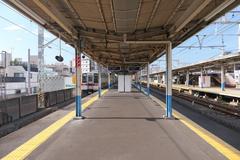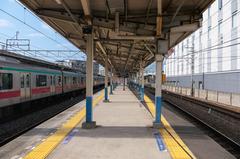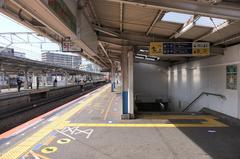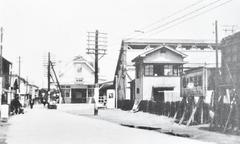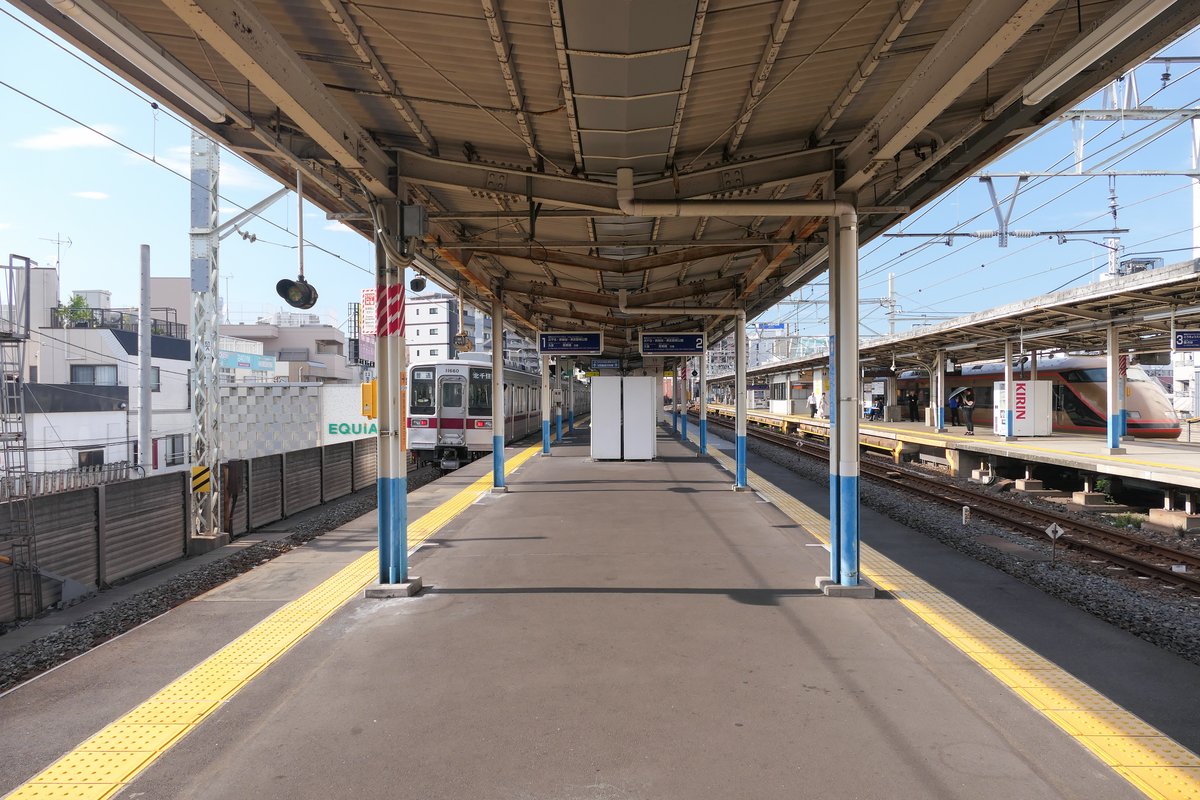
Hikifune Station Tokyo: Visiting Hours, Tickets, and Travel Guide
Date: 15/06/2025
Introduction
Hikifune Station, situated in Tokyo’s Sumida Ward, is more than a convenient railway stop—it’s a dynamic gateway to the cultural heart of eastern Tokyo. Since its opening in 1902 on the Tobu Isesaki Line, Hikifune has evolved into an essential transit hub, connecting visitors to must-see landmarks like Tokyo Skytree, Sumida Aquarium, and revered shrines such as Takagi and Mimeguri. The station’s surroundings offer a rich tapestry of Edo-period neighborhoods, riverside walks, vibrant festivals, and culinary delights—making it an ideal starting point for an immersive Tokyo adventure (Tobu Railway website, Go Tokyo, Japan Experience).
Historical Development and Significance
Opened in 1902 as part of Tokyo’s early 20th-century railway expansion, Hikifune Station (曳舟駅, Hikifune-eki) was named for the area’s history as a river transport hub along the Sumida River. Over the decades, the station has been modernized to accommodate rising passenger numbers and urban growth, becoming a vital node for both commuters and tourists (Namu Wiki).
Role in the Tokyo Rail Network
Connectivity:
Hikifune is a key interchange on the Tobu Skytree Line (formerly Tobu Isesaki Line) and the Tobu Kameido Line, providing direct links to Asakusa, Oshiage (Tokyo Skytree), and Kameido, with further connections to JR and Tokyo Metro lines. This connectivity makes Hikifune a strategic station for accessing central Tokyo, Saitama, and Sumida’s cultural attractions (Go Tokyo).
Passenger Volume:
Serving tens of thousands daily, Hikifune acts as a neighborhood hub and feeder to larger terminals. Its design ensures smooth passenger flow even during peak hours.
Urban Integration:
The station has spurred residential and commercial growth in Sumida, especially after the construction of Tokyo Skytree, further cementing its role as a gateway for tourists and locals alike (Japan Experience).
Architecture and Station Layout
Hikifune Station features two main platforms for the Skytree Line and a separate platform for the Kameido Line. The station is equipped with elevators, escalators, and pedestrian overpasses for barrier-free access. Modern amenities include multilingual ticket machines, digital information displays, and clear signage.
Cultural and Historical Highlights
Local Heritage
Hikifune’s name and location reflect its roots in river commerce. Nearby, Takagi Shrine (established in 1468) preserves local Shinto traditions and is notable for its purple color and onigiri motifs (Japan Experience).
Modern Relevance
Hikifune now serves as an access point to the Tokyo Skytree, supporting both tourism and local community life through events and festivals.
Practical Visitor Information
Access, Hours, and Tickets
- Station Hours: Daily, approx. 5:00 AM – midnight
- Tickets: Purchase single-ride tickets at machines or use IC cards (Suica, PASMO)
- Accessibility: Elevators, escalators, and accessible restrooms
Facilities
- Automated ticket gates and IC card readers
- Lockers and restrooms
- Convenience stores/kiosks
- Multilingual signage
Major Nearby Attractions
Tokyo Skytree and Solamachi
Tokyo Skytree is a 634-meter landmark with observation decks (open 8:00 AM–10:00 PM, last entry 9:00 PM; tickets ¥2,100–¥3,100/adult). The Solamachi complex at its base offers shopping, dining, and entertainment.
Sumida Aquarium
Located in Solamachi, the Sumida Aquarium is open 9:00 AM–9:00 PM (adults ¥2,300, children ¥900), featuring open-concept habitats and innovative exhibits.
Takagi Shrine
A tranquil shrine near the station, Takagi Shrine is open 24/7 (office hours 9:00 AM–4:00 PM), with free entry.
Mimeguri Shrine
Mimeguri Shrine is another peaceful retreat, open daily from dawn to dusk, and known for its connection to local folklore.
Kirakira Tachibana Shopping Street
A retro shopping arcade with local food stalls and shops, most open 10:00 AM–7:00 PM.
Tower View Shopping Street
A blend of traditional and modern shops, including artist-run boutiques, generally open 11:00 AM–8:00 PM (Evrimagaci).
Mukōjima-Hyakkaen Garden
This historic flower garden is open 9:00 AM–5:00 PM, with guided tours on weekends and seasonal events (Tokyo Cheapo).
Kototoi Bridge
A scenic spot for photos, especially during cherry blossom season (Atlas Obscura - Kototoi Bridge).
Seasonal Events and Festivals
- Torikoe Festival (June): Mikoshi parade and lantern displays
- Hydrangea and Iris Festivals (June): Seasonal flower events in local parks
- Cultural Workshops: Artisanal crafts, food fairs, and community gatherings
Culinary Experiences
- Local Eateries: Ramen, sushi, and Japanese street foods abound around the station and shopping streets
- Cafes and Bistros: Modern dining options featuring locally sourced ingredients
Visitor Tips
- Best Times: Visit on weekday mornings or during spring/autumn for pleasant weather and fewer crowds
- Navigation: Use IC cards for transit, and bilingual maps/apps for wayfinding (MetroCazar Tokyo)
- Luggage: Coin lockers available; consider luggage forwarding for busy periods
- Community Engagement: Participate in local events and support small businesses for an authentic experience
Frequently Asked Questions (FAQ)
Q: What are Hikifune Station’s operating hours?
A: Approx. 5:00 AM to midnight daily.
Q: How do I purchase tickets?
A: Use automated machines or IC cards like Suica and PASMO.
Q: Are there guided tours?
A: Yes—Mukōjima-Hyakkaen Garden and Tokyo Skytree offer guided tours; local walking tours also available.
Q: Is Hikifune Station accessible?
A: Yes, with barrier-free facilities and staff assistance.
Q: What are the main attractions nearby?
A: Tokyo Skytree, Sumida Aquarium, Takagi Shrine, Mimeguri Shrine, Mukōjima-Hyakkaen Garden, and local shopping streets.
Visuals and Media
For interactive maps and virtual tours, visit the official Tobu Railway website and Go Tokyo.
Conclusion and Visitor Recommendations
Hikifune Station is your portal to the charm and depth of Tokyo’s eastern neighborhoods. From panoramic city views at Tokyo Skytree to tranquil moments at historic shrines, and from vibrant local festivals to retro shopping streets, Hikifune offers experiences for every traveler. Leverage IC cards for smooth transportation, explore during off-peak hours for a relaxed atmosphere, and savor local flavors in the district’s eateries. For up-to-date information and curated guides, visit the Tobu Railway website and Go Tokyo, and consider downloading the Audiala app for additional tips and exclusive offers.
Useful Links
- Tobu Railway website
- Go Tokyo
- Japan Experience - Takagi Shrine
- Tokyo Cheapo Hikifune Guide
- MetroCazar Tokyo Transit App
- Atlas Obscura - Takagi Shrine
- Evrimagaci - Hikifune Cultural Spotlight
- Official Hikifune Shrine Website
This guide is designed to help you make the most of your journey to Hikifune Station and its surrounding treasures. For more itineraries and cultural insights, follow us on social media and stay connected with the Audiala app.
